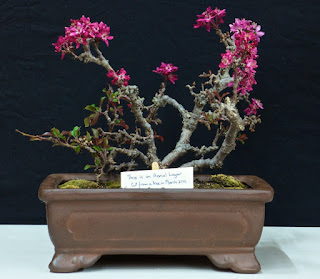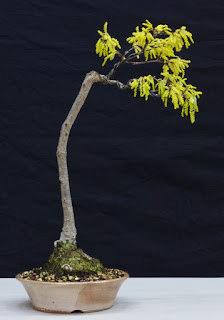2015 September Meeting - Peter Fewster Demonstration
At the September meeting, Peter Fewster shared many ideas on grafting and air layering. Many of these originated from experiments by Peter to try and find whether different techniques produce good outcomes. If you missed this interesting presentation, below are some of his thoughts for consideration.
* Air layers are best when the tree is in full leaf. Use a sharp knife for clean cuts and think about the angle of the cut in the context of desirable styling outcomes.
* The width of the air layer cut should be about the diameter of the branch plus 50%. Make sure none of the cambium layer is left in the cut area.
* If using sphagnum moss, cutting it into smaller pieces can assist when trying to remove it later. A mixture of sphagnum moss and sand or vermiculite may also be used.
* Air layering Black Pines is not difficult if you can keep the tree growing vigorously. He sees this as an excellent way to make good use of sacrificial branches when their job is done. Diameter of the air layer is not considered an issue if the tree is growing vigorously.
* For Pines, Peter maintains you can get better results with air layers if you wait until the roots are a brown colour. White roots can be very brittle.
* If removing the sphagnum moss is difficult when separating the layer, leave for twelve months and remove it then.
* Peter has seen thread grafting work on Black Pines. Use glad wrap to confine the needles when threading the graft.
* Peter has achieved radical taper quickly on black pines by applying aluminium wire tightly to the section needing taper, placing the tree in a large pot and feeding strongly. Think about an irregular pattern of the wire as eventually the trunk will grow around the wire and cover it. It is important to manage the fertilising regime to match the tree growth so the roots are not burnt.
Below are photos of Peter demonstrating his techniques.
 |
| Cutting the air layer |
 |
| Radical taper example - see growth around the wire. |
 |
| Air layer all wrapped up. |
BSV Members trees were also on display and a selection are included below. Wisteria's particularly seem to have benefitted from recent weather conditions with many flowers.
 |
| Crab Apple |
 |
| White Pine |
 |
| Blue Cedar |
 |
| Lilac |
 |
| Azalea |
 |
| Wisteria |
 |
| Recent air layer - Crab Apple |
 |
| Wisteria |
 |
| Leptospernum |
 |
| Quercus dentata - Daimyo Oak |
 |
| Chinese Elm |
 |
| Pinus radiata |
 |
| Wisteria |
